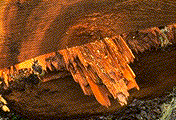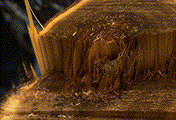Archived Content
Information identified as archived on the Web is for reference, research or recordkeeping purposes. It has not been altered or updated after the date of archiving. Web pages that are archived on the Web are not subject to the Government of Canada Web Standards. As per the Communications Policy of the Government of Canada, you can request alternate formats on the Contact Us page.
White Butt Rot - White Laminated Rot
Ceriporiopsis rivulosa (Berk. & Curtis) Gilb. & Ryvarden
(= Poriarivulosa (Berk. & Curtis) Cooke)
(=Poria albipellucida D. Baxter)
Basidiomycotina, Aphyllophorales, Polyporaceae
Hosts:Ceriporiopsis rivulosa has been reported in B.C. on western redcedar, western hemlock, Douglas-fir, white and Sitka spruce, and amabilis fir. Elsewhere in North America it has also been found on grand fir, sequoia, and in Idaho on larch.
Distribution: This fungus is widely distributed throughout the range of its hosts in B.C.
Identification: The fruiting bodies are annual, thin (up to 3 mm thick), resupinate, poroid and white, forming mostly on slash. They are quite rare and are less useful for identification than are decay symptoms. Fruiting bodies have not been found on sequoia.
The early stage of the decay appears as a yellow discoloration in the heartwood, sometimes surrounded by a blue-to-red stain. Radial cracks may form through the decayed wood as it dries. In the late stage of the decay, the annual rings separate to form coarse laminations or a crumbly mass (Figs. 8a, 8b). Decay symptoms are sometimes not conspicuous in freshly cut logs, but as drying occurs, the wood delaminates along annual rings.
Microscopic Characteristics: Pores angular, 3-4 per mm. Generative hyphae with clamps, irregularly branched. Basidiospores subglobose to oval, hyaline, smooth, IKI-, 5-6 x 6-8 µm.
Growth in culture rapid, mat white, laccase positive, clamp connections, globose-terminal or intercalary chlamysospores. Stalpers: 1 (2) 3 (5) (6) (7) (11) 13 (14) (16) 17 18 21 22 (24) 30 (37) (39) 40 42 45 48 50 52 53 (55) 57 (78) (80) 82 83 (84) 85 (89) (90) (93).
Damage:Ceriporiopsis rivulosa is recognized as the most important butt rot of mature western redcedar in the coastal regions of British Columbia. Since decay develops readily early in the life of the tree (when pole-sized), butt logs of mature trees often have significant levels of damage.
Remarks: The decays caused by C. rivulosa and the cedar form of Phellinus weirii are very similar in gross appearance, particularly in early stages of decay. However, they can be distinguished when laminations form; C. rivulosa shows conspicuous, white mycelial flecks between the laminae, and the final stages of decay is crumbly. In contrast, Phellinus weirii develops dark brown setal hyphae between the laminations and the wood shows long striations of white cellulose-like material. These striations gives the final decay a fibrous texture. In culture C. rivulosa produces clamp-connections whereas P. weirii does not.
References:
Buckland, D. C. 1946. Investigations of decay in western Red Cedar in British Columbia. Can. J. For. Res. 24: 158-181.
Gilbertson, R. L. and L. Ryvarden. 1986. North American Polypores. 1:194. Fungiflora, Oslo.
Figures
Click on any image to see the full size version.
Press "Back" on your browser to return to this screen.

Figure 8a: Laminate decay in western redcedar caused by C. rivulosa.

Figure 8b: Laminate decay in western redcedar caused by C. rivulosa.
 This Web page has been archived on the Web.
This Web page has been archived on the Web.